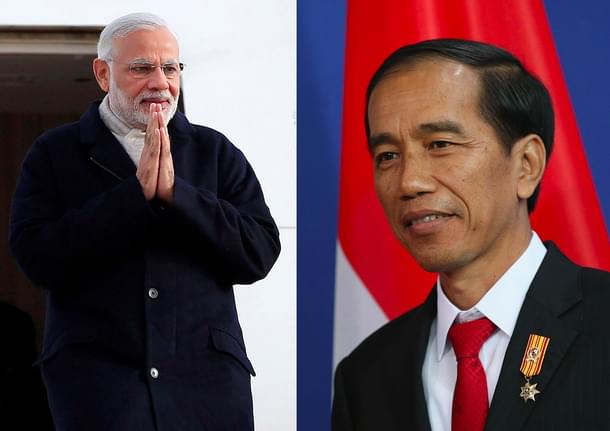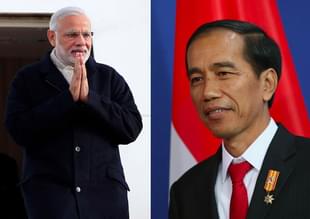World
Time For Delhi And Jakarta To Get Serious
Harsh V Pant
Dec 11, 2016, 05:12 AM | Updated 05:12 AM IST
Save & read from anywhere!
Bookmark stories for easy access on any device or the Swarajya app.


President Joko “Jokowi” Widodo will be in India on a two-day state visit next week, his first visit to India after assuming power in October 2014. This will also be the first bilateral visit at this level since the coming to office of the Modi government in May 2014. It was in 2011 that then Indonesian President Susilo Bambang Yudhoyono had visited India to attend India's Republic Day celebrations. Jokowi’s visit will not just mark another step in India's “Act East” policy of encouraging greater engagement and integration between India and Southeast Asia. It will also signal two large democracies growing closer as authoritarian China grows more menacing and America’s future posture towards Asia continues to be mired in uncertainty.
The visit is part of a broader pattern: Prime Minister Narendra Modi has made moves to ensure a great Indian profile in Southeast Asia and has made it clear that his government's foreign-policy priority will be East and Southeast Asia, which are poised for sustained growth in the 21st century. And the regional states have welcomed a growing role for India as Chinese aggression becomes an everyday reality.
The basis of the India-Indonesia partnership dates back to the founding fathers of these two nations—Jawaharlal Nehru and Sukarno—who offered a distinct foreign policy worldview that drew on their shared colonial experiences. In the last decade, both New Delhi and Jakarta's worldview may have changed a bit, but the potential for partnership hasn't. India with its Act East policy substantially enhanced its presence in the region while Indonesia took the lead in bringing one of the world's fastest growing economies closer to Asean. Both India and Indonesia want to seize the opportunities offered by landmark economic growth in Asia.
Economic engagement between the two is growing rapidly, and gained further momentum with the signing of the India-Asean free-trade agreement in 2010. The deal committed New Delhi to cut import tariffs on 80 per cent of the commodities it trades with Asean, with the goal of reversing India's growing marginalization in the world's most economically dynamic region. The FTA focused on trade in goods; India and Asean are now in talks to widen the agreement to include services and investment. India-Asean bilateral trade reached $80 billion in 2014 and increasing by an average annual rate of 23 per cent over the past decade.
Indonesia will figure prominently in India's economic engagement with Southeast Asia. Beyond the regional FTA, India and Indonesia have started negotiations on a comprehensive economic cooperation agreement that would further liberalize trade. Indonesia is an important source of energy and raw materials for India. Indonesia is India's second largest trading partner in Asean and bilateral trade between India and Indonesia stood at $20 billion in 2015. Major Indian companies, including the Birla group, the Tatas, Essar, Jindal Steel and Bajaj Motors, are operating in Indonesia. Indian investment is spread across banking, mining, oil and gas, iron and steel, aluminium, IT, textiles and telecommunications, among other industries.
India and Indonesia also have been steadily adding enhanced security and political ties as well. The two signed a strategic partnership agreement in 2005 that started an annual strategic dialogue. The next year they ratified a defence cooperation agreement, initially signed in 2001, which focused on areas of defence supplies and technology, as well as on joint projects. The two have signed an extradition treaty and also a "mutual legal assistance treaty" for gathering and exchanging information to enforce their laws. Joint naval exercises and patrols, and regular port calls by their respective navies, have become a regular feature of the India-Indonesia relationship in recent years. India has also become a major source of military hardware for Jakarta.
Such cooperation is a natural result of geography. Indonesia's location, combined with its naval forces, allows it to work effectively with India to ensure security in the sea lanes of communication between Europe, the Middle East and Southeast Asia. Together they control the entry point from the Bay of Bengal in the Indian Ocean to the Straits of Malacca. Similarities in democratic governing systems and broad foreign-policy outlooks have helped dramatically: Viewing India's maritime presence as benign, Indonesia has openly invited India to help littoral states in the region maintain the Straits' security.
All of this is significant because it stands in stark contrast to China's approach to its waters, which has more often than not deteriorated to outright aggression. Unlike China's rise, which is increasingly viewed in the region as a reason for suspicion and alarm, India's poses no such threats. While it is large, its democratic governance leads to greater transparency in its foreign-policy motives, which in turn makes it easier for partners to feel comfortable working with New Delhi. Cooperation with Indonesia offers a clear example of what a greater role for India in Southeast Asia would look like, and as such gives other countries in the region little cause for concern.
New Delhi's ambitious policy in East and Southeast Asia is aimed at significantly increasing its regional profile. Smaller states in the region are now looking to India to act as a balancer in view of China's growing influence, while larger states also see it as an attractive engine for regional growth. It remains to be seen if India can indeed live up to its full potential, as well as to the region's expectations. But with the Modi government’s wooing of regional states, India is signalling that it is indeed serious about its presence in Southeast Asia. As India moves away from its traditional ‘non-aligned’ mentality, President Jokowi’s visit can perhaps usher a new era in the bilateral relations between two of the most prominent Indo-Pacific powers.
Harsh V Pant is a Distinguished Fellow at Observer Research Foundation and Professor of International Relations, King’s College London.





